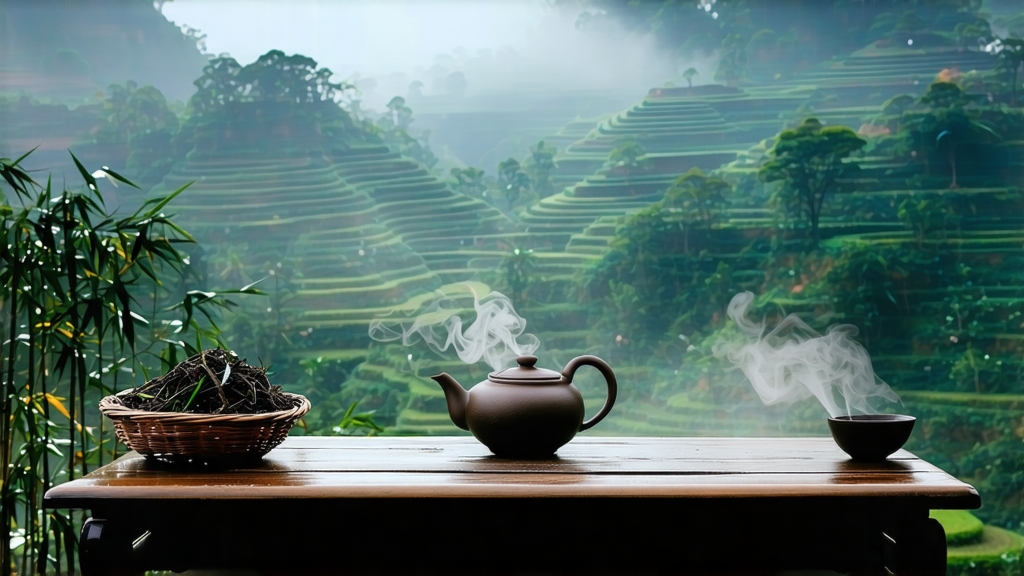
Tucked away in the humid, karst-pitted mountains of southern Guangxi, Liu Bao tea has spent four centuries quietly perfecting the art of patience. To most of the world “dark tea” means ripe Pu-erh, yet connoisseurs who follow the serpine Xun River to the old port of Wuzhou discover a deeper, duskier treasure—one that once rode bamboo rafts down the Pearl River and perfumed the holds of junks bound for Hong Kong and Malaya. Today Liu Bao is staging a global renaissance, propelled by its mellow, betel-nut sweetness and a folklore that links every leaf to the horse caravans and dockside warehouses that first taught it how to age.
Historical footprints
The earliest written record appears in the 1686 gazetteer of Cangwu County: “Dark leaf from Liu Bao village relieves dampness and is bartered for salt by the Yao tribes.” By the Qing dynasty the tea had become a tax commodity; the imperial court accepted it as tribute and shipped it north to satisfy the milk-tea cravings of Mongolian princes. In 1886 the British consul in Wuzhou noted “a peculiarly fragrant black brick much esteemed by the Malays,” proving Liu Bao had already slipped through colonial fingers and entered the steamships of empire. The twentieth century brought wars and trade embargoes; production withered until 1958 when the state re-established the Wuzhou Tea Factory and standardized the now-famous “three-year wet-pile, seven-year air-mature” rhythm. The 2008 opening of the Beijing Tea Expo introduced Liu Bao to international judges, who awarded it a gold medal and a new passport to the world.
Micro-terroirs and leaf styles
Liu Bao is not a single recipe but a mosaic of micro-terroirs scattered within a 30-kilometre radius of Liu Bao township. The core gardens—He Ping, Tang Ping, and Xian Dao—sit at 300–500 m on decomposed granite soils that drain the region’s 1,600 mm of annual rainfall in hours, forcing tea roots to plunge deep for minerals. Traditional cultivar is the Yunnan-large-leaf descendant locally called “medium-leaf phoenix,” whose plump buds contain 32 % polyphenols and an unusually high 5 % of theanine, precursors for the tea’s later cocoa-like sweetness.
Farmers recognize three harvest windows—spring bud (qing ming), summer rain (duan wu), and autumn dew (qiu fen)—but only the spring pick is deemed worthy of long aging. After picking, the leaves are sorted into four grades:特级 (special), 一级 (first), 二级 (second), and 三级 (third), determined by bud ratio and vein lignification. The special grade, nicknamed “golden melon,” keeps 30 % downy tips and is pressed into 250 g commemorative gourds; the third grade, called “old firewood,” is mostly mature leaf destined for wholesale baskets that will season for decades.
Crafting darkness: from shaqing to wet-piling
Unlike the sun-dried roughness of sheng Pu-erh, Liu Bao undergoes a gentle kill-green at 160 °C for three minutes, just enough to halt oxidation while preserving leaf enzymes. The hot leaves are then rolled for 25 minutes on a 1950s cast-iron roller whose wooden ribs have polished to a coffee sheen. What follows is the critical “dui zi” wet-piling, a Guangxi invention that predates Yunnan’s wo dui by at least a century.
Workers build 1.2-metre-tall heaps inside underground chambers whose walls ooze groundwater year-round. The pile is sprayed with mineral-rich spring water, covered with jute sacks, and left to ferment for 30–45 days. Internal temperature is monitored by inserting a bamboo pole; when the core hits 62 °C the pile is turned, a ritual repeated six times. Humidity hovers at 85 %, fostering a microbial consortium dominated by Aspergillus niger, Blastobotrys adeninivorans, and a rare yeast Kodamaea ohmeri that together hydrolyze bitter catechins into mellow theaflavins and thearubigins. The finished mao cha smells of wet camphor and jackfruit, a signature known locally as “betel-nose aroma.”
Post-fermentation the tea is steamed